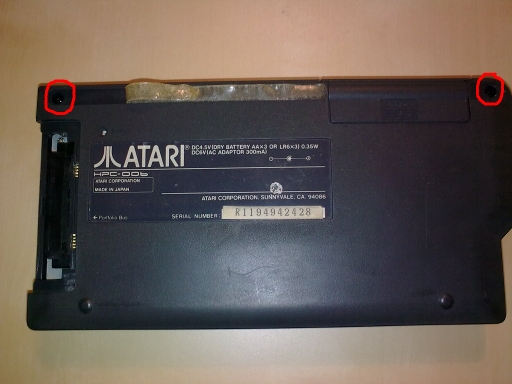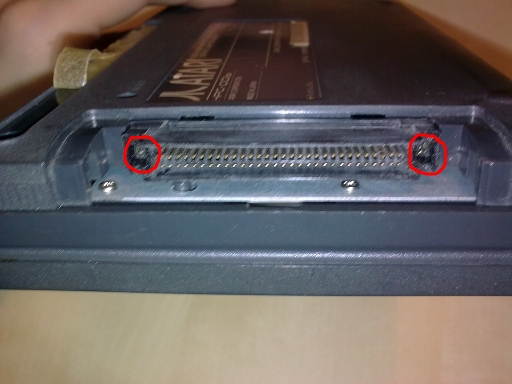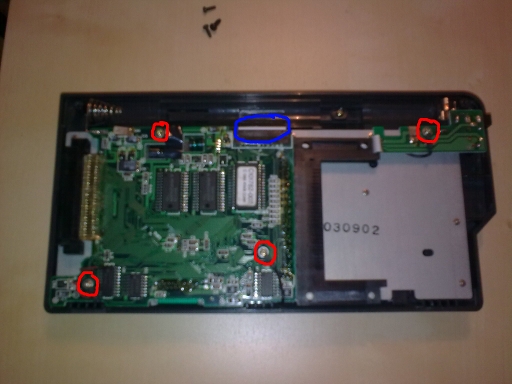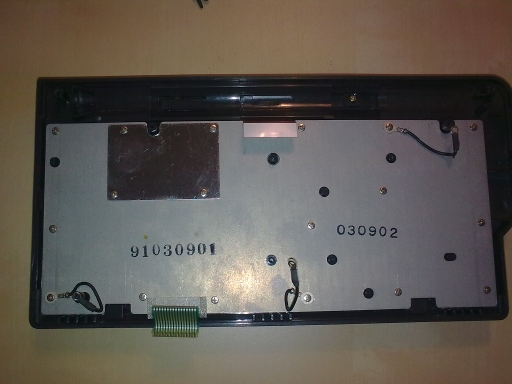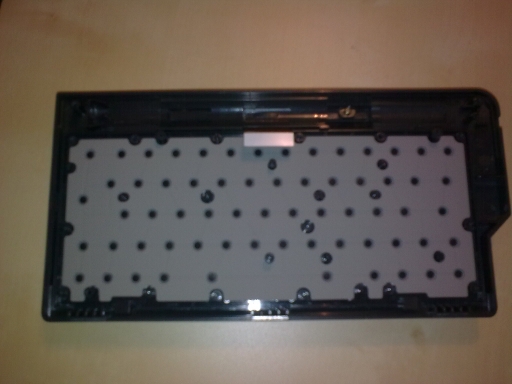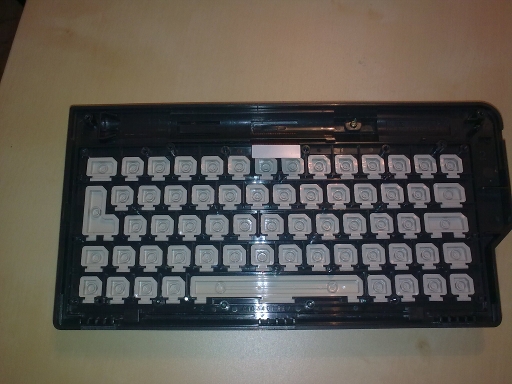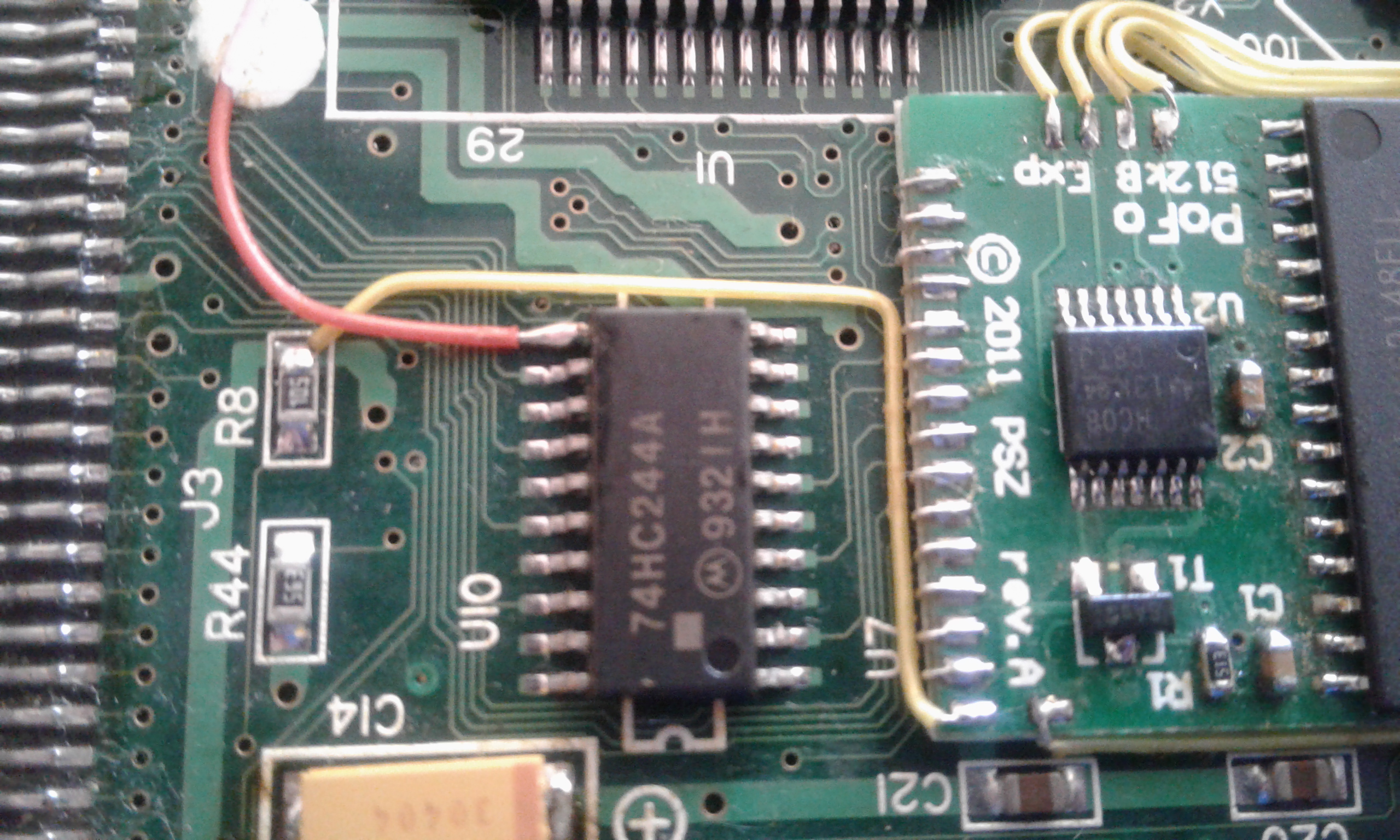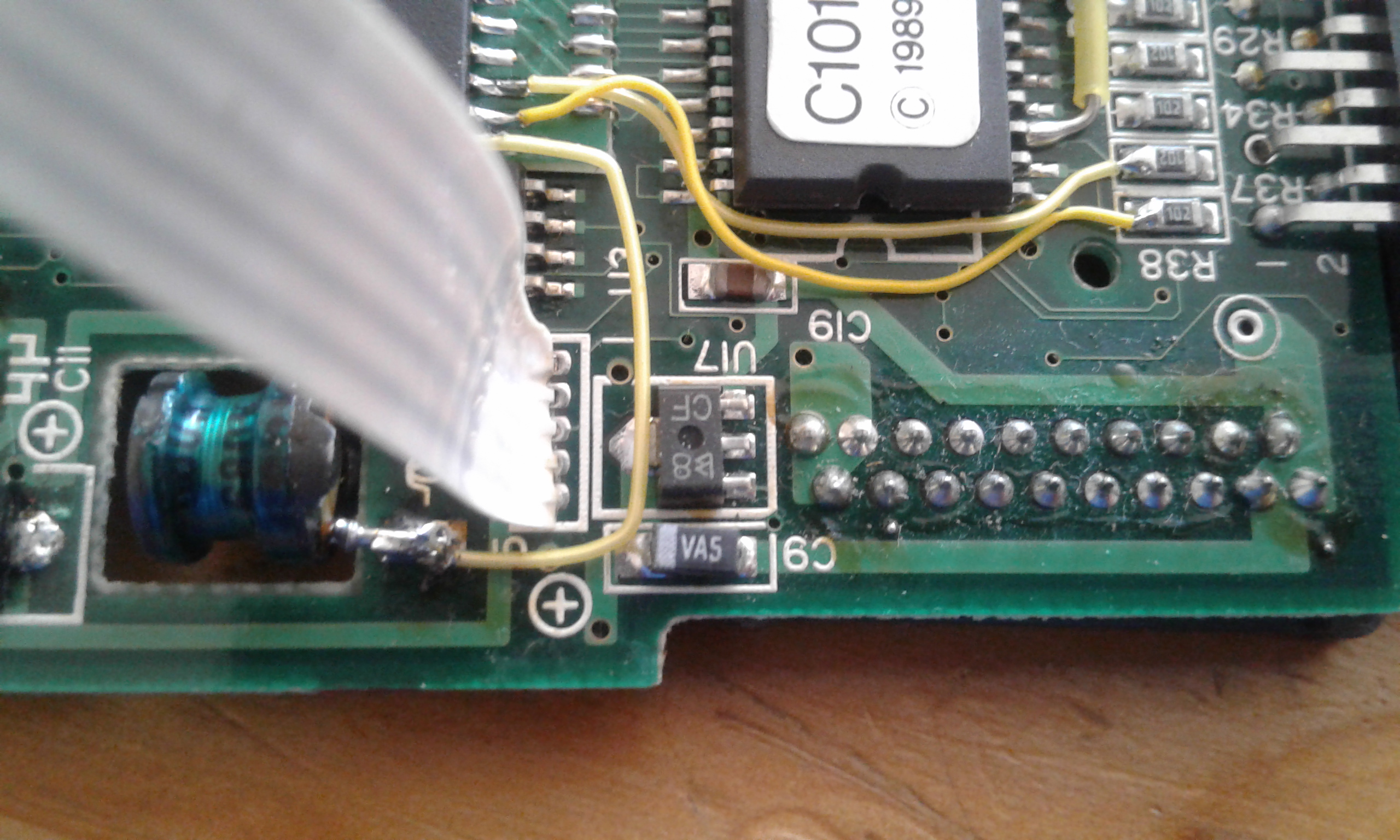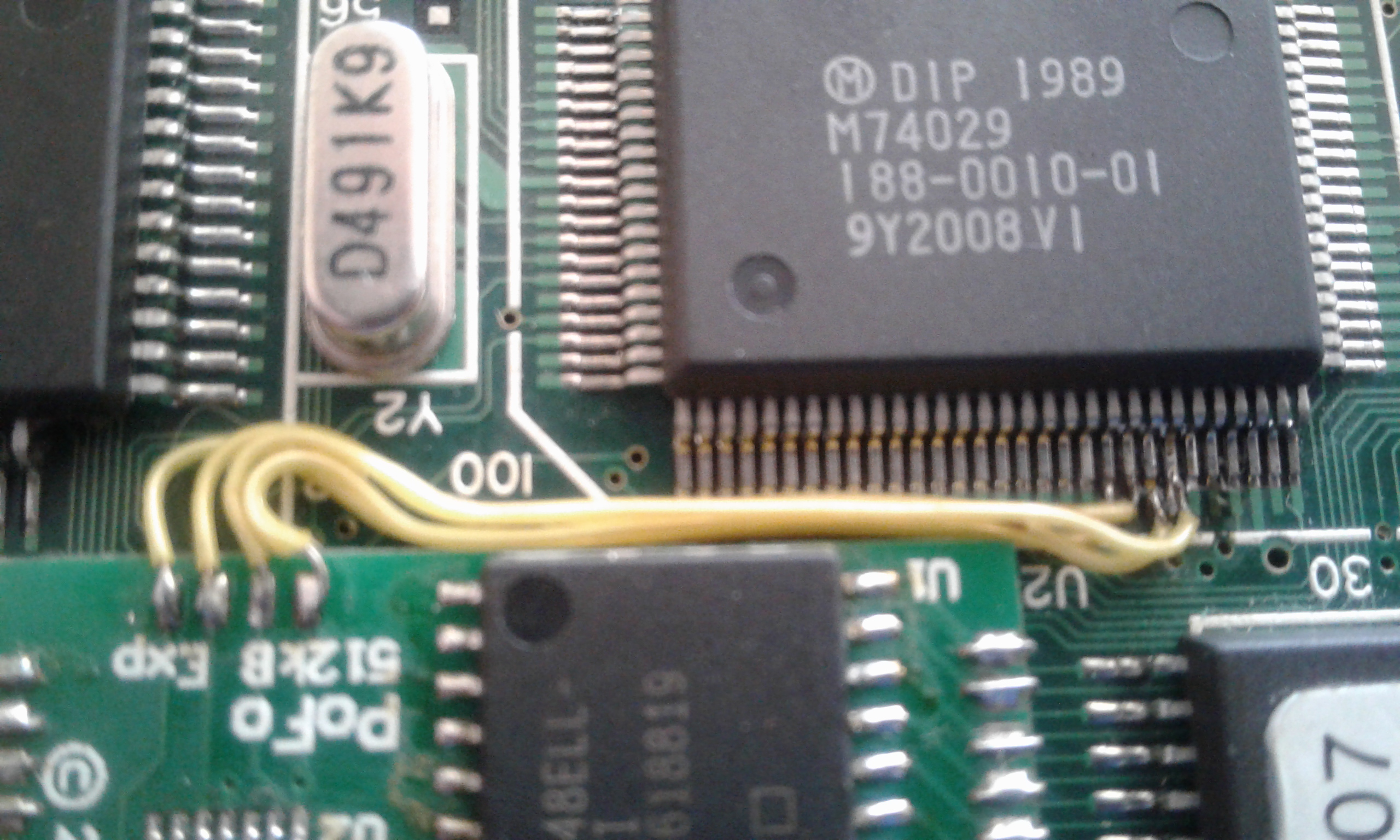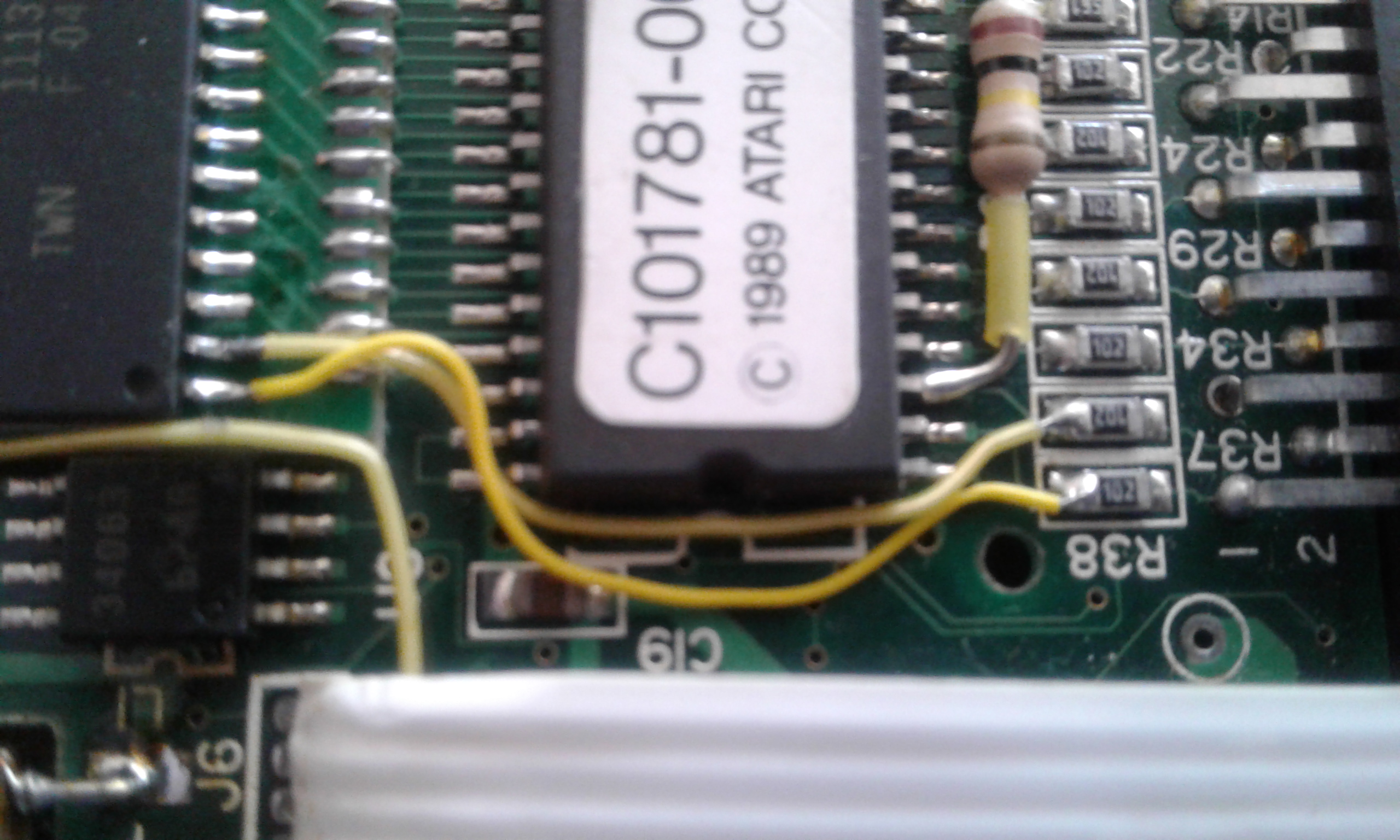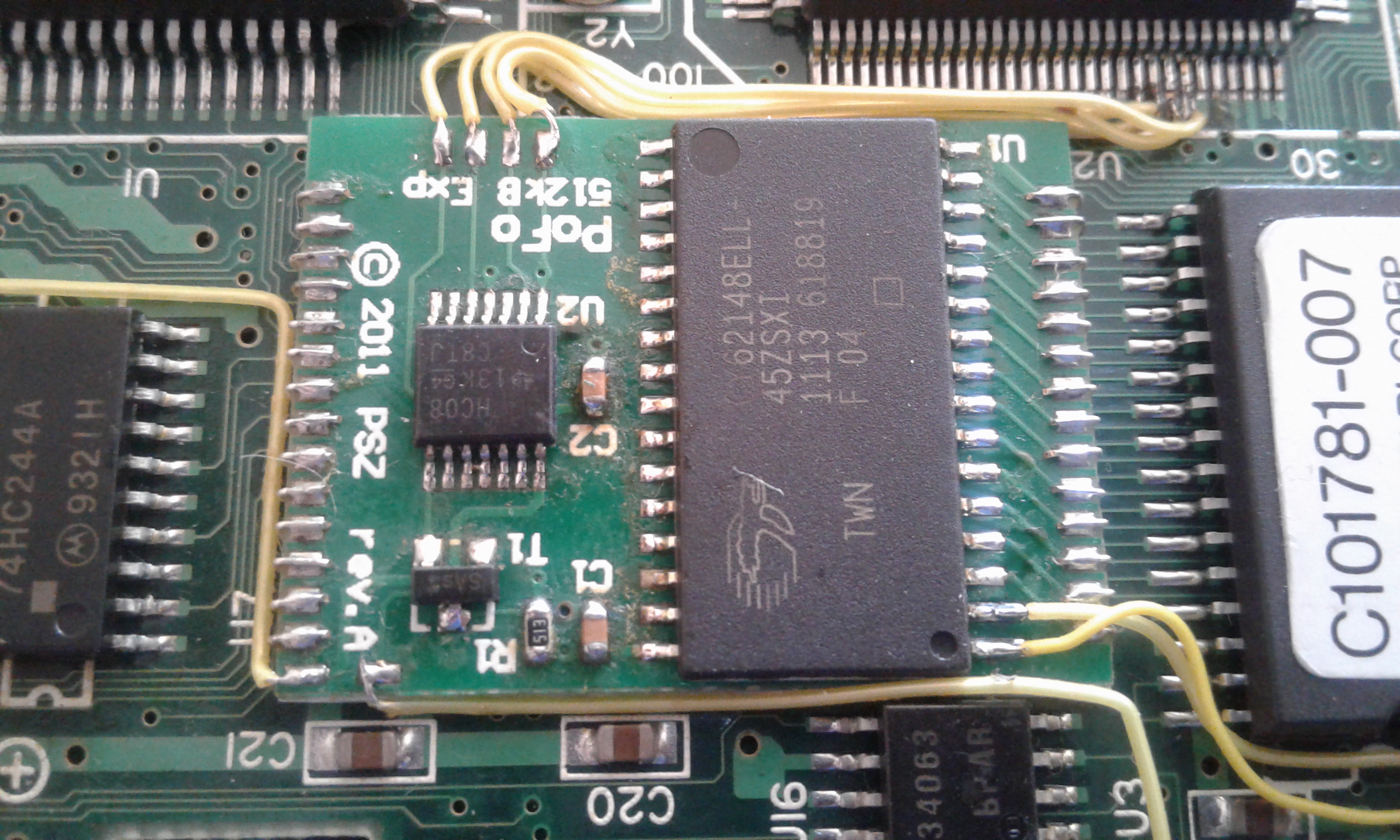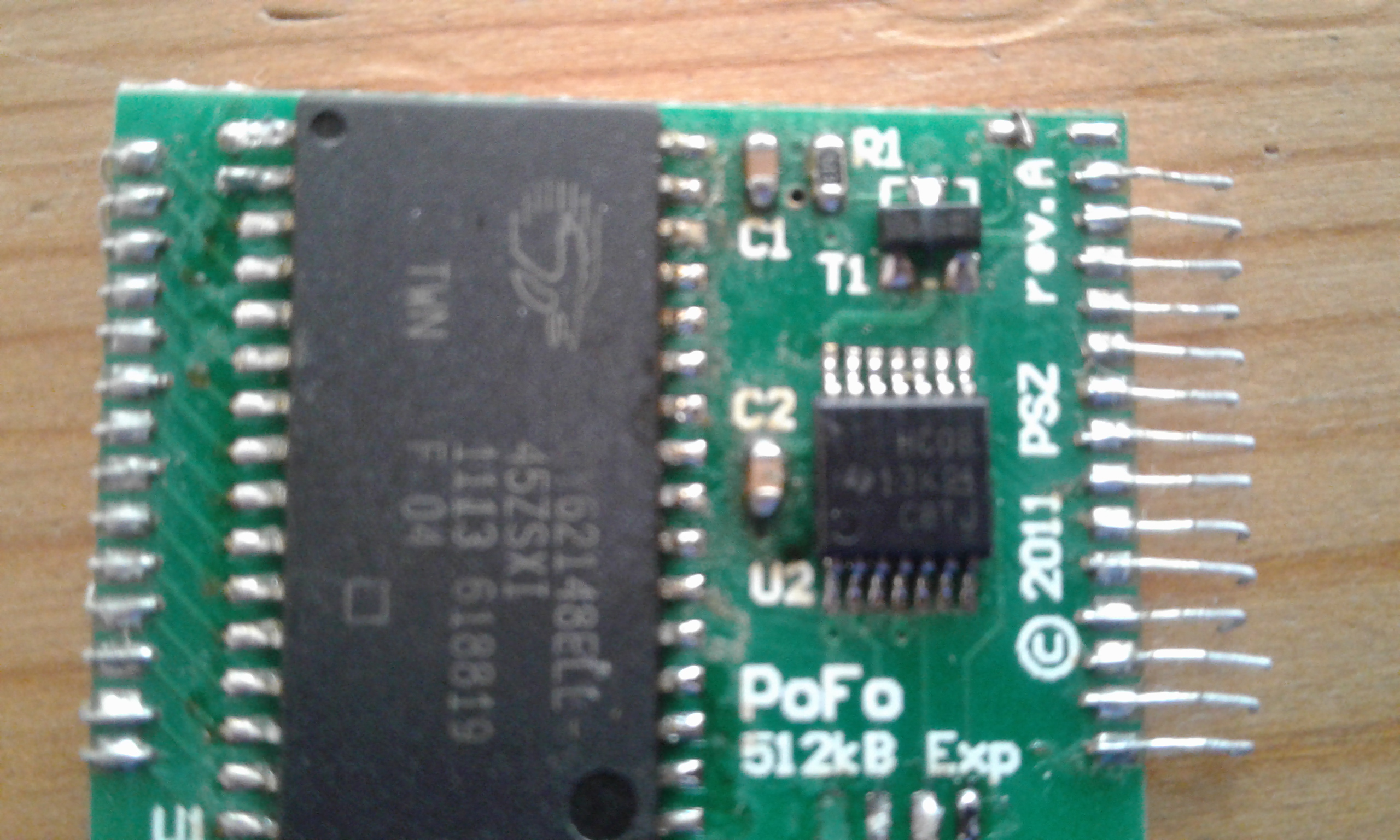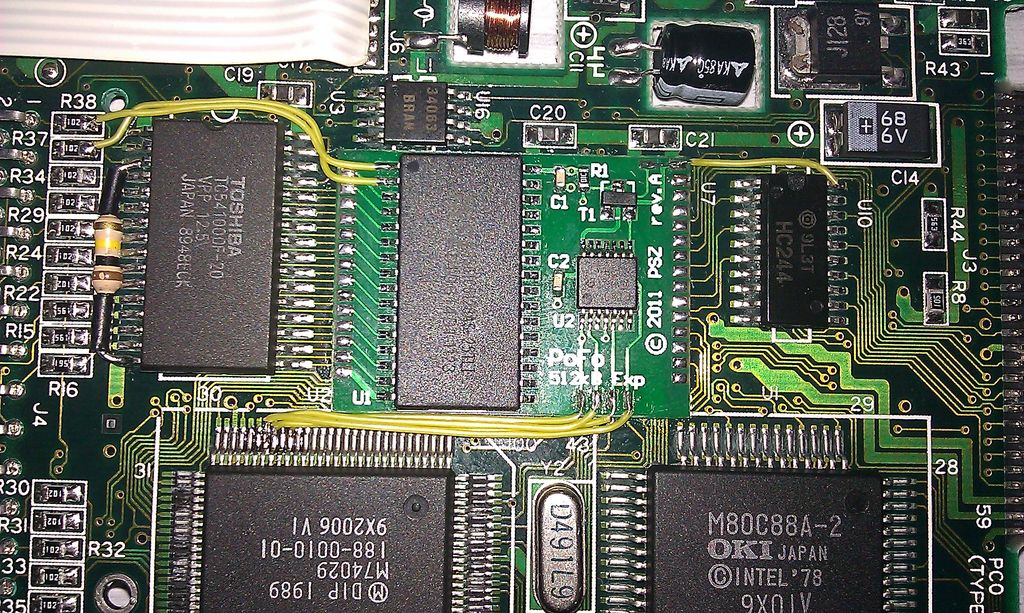Atari Portfolio on Reddit

I've created a new subreddit /r/AtariPortfolio, dedicated solely to the Pofo.
Atari Portfolio (and old palmtops in general) is barely discussed on Reddit. Once a few months you can find a mention on /r/retrocomputing, and that's all. I hope this will change a bit.
DH’s hacks for the Portfolio
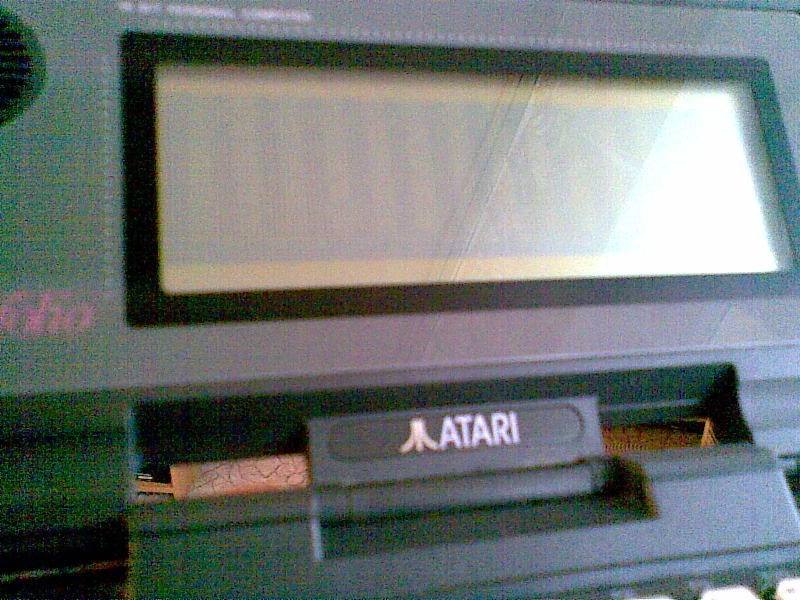
I wanted to post this months ago, but it seems that long winter breaks have become a tradition on this blog.
In October last year, a reader called DH wrote a comment with his own proposition of a .com-file generator for a bare Portfolio (without any communication interface). His implementation used octal codes instead of hex, but was easier to type in. All you need is to type this at the command prompt (see the original post):
echo /180 ^P /208 /236 /205 ! /168 /223 t ^Q /168 @ u ^U /131 /224 ^O /177 ^D /254 /201 /211 /226 ^A /194 /235 /229 /180 ^B /205 ! 1 /210 /235 /221 /205 [spc] /144 > b8cat.com
where ^P means Ctrl+P, /180 means Alt+1 8 0 when NumLock is on, and [spc] obviously is Space. If you don't make any mistake, you should now have a tool, which will allow you to create executable .com files from octal codes.
DH reverse-engineered DEBUG.COM from MS-DOS 2.0 and put it on Dropbox, so that after re-typing it (remember those listings in computer magazines back in the days?) you'll have this useful tool on your Portfolio.
That's not all. After a while, DH responded again, this time with a hexadecimal-code .com generator:
echo 1 \210 \180 ^P \208 \236 \205 ! \168 @ u ^T \168 [spc] t \242 \168 ^P u ^P \168 ^A u ^X \180 ^B \205 ! 1 \210 \235 \226 ^D ^E ^D ^D $ ^O \177 ^D \211 \226 0 \228 ^A \194 \235 \210 \205 [spc] \144 > b16cat.com
This is a great replacement to h2c.com, described in my post, since it's much easier to type in, it reads hex codes separated by spaces and ignores line breaks (so preparing the input is much easier). Input files must be terminated with "!" (exclamation mark).
Here's MORE.COM transcribed into hex codes:
B4 30 CD 21 86 E0 3D 00 02 73 09 BA FC 01 B4 09 CD 21 CD 20 C6 06 E7 01 19 B4 0F CD 10 88 26 E8 01 BA 17 02 B4 09 CD 21 33 DB B4 45 CD 21 8B E8 B4 3E CD 21 BB 02 00 B4 45 CD 21 FC BA 1A 02 B9 00 10 8B DD B4 3F CD 21 0B C0 75 02 CD 20 8B C8 8B F2 AC
3C 1A 74 F5 3C 0D 75 07 C6 06 EA 01 01 EB 4C 3C 0A 75 06 FE 06 E9 01 EB 42 3C 08 75 0D 80 3E EA 01 01 74 37 FE 0E EA 01 EB 31 3C 09 75 12 8A 26 EA 01 80 C4 07 80 E4 F8 FE C4 88 26 EA 01 EB 1B 3C 07 74 17 FE 06 EA 01 8A 26 EA 01 3A 26 E8 01 76 09 FE
06 E9 01 C6 06 EA 01 01 8A D0 B4 02 CD 21 8A 26 E9 01 3A 26 E7 01 72 20 BA F0 01 B4 09 CD 21 B4 0C B0 01 CD 21 BA 17 02 B4 09 CD 21 C6 06 EA 01 01 C6 06 E9 01 01 4E 41 49 74 03 E9 6E FF E9 54 FF 18 50 01 01 00 00 00 00 00 0D 2D 2D 20 4D 6F 72 65 20
2D 2D 24 4D 4F 52 45 3A 20 49 6E 63 6F 72 72 65 63 74 20 44 4F 53 20 76 65 72 73 69 6F 6E 0D 0A 24 00 00 00 00 00 00 00 00 00 00 00 00 00 00 00 00 00 00 00 00 00 00 00 00 00 00 00 00 00 00 00 00 00 00 00 00 00 00 00 00 00 00 00 00 00 00 00 00 00 00
00 00 00 00 00 00 00 00 00 00 00 00 00 00 00 00 00 00 00 00 00 00 00 00 00 00 00 00 00 00 00 00 00 00 00 00 00 00 00 00 00 00 00 00 00 00 00 00 00 00 00 00 !
(Remember to terminate each line - except the last - with space!)
But that's not all. After a while, DH responded again 🙂 Here's his advice on receiving files via RS-232 without comms software:
To receive a file sent by RS-232 using MORE.COM, on the Portfolio, execute “MORE <COM1 >FileName” (replacing “FileName” with the name under which to save the file). This will stream data from the COM port directly to the file (assuming no ^Z is encountered) WITHOUT locking up the keyboard! This allows you to advance the stream by repeatedly pressing Enter until the program automatically ends, signalling a complete transfer. It also means that you can still use CTRL+C if something goes wrong (something “COPY COM1 FileName” wouldn’t let you do, since it replaces all keyboard input with the COM port instead of simply opening it alongside). My Serial Interface hasn’t come through the post yet, so if someone with their own can test this for me, that would be great thanks!
The last (as for now) contribution by DH is a version of MORE.COM that can be typed in from command prompt without using B16CAT:
\176 ^N \254 \200 \162 4 ^B \162 \92 ^B , ^D \254 \192 \162 5 ^B \162 ] ^B \180 0 \205 ! \134 \224 H = \254 ^A w ^K \186 A ^B \180 ^R \208
\236 \205 ! \205 [SPACE] \198 ^F 0 ^B ^Y \180 ^O \205 ^P \134 \224 \162 1 ^B \144 \144 \144 \144 1 \219 \180 E \205 ! \137 \197 \180 = \254
\196 \205 ! \187 ^B \128 \129 \227 ^O ^A \180 E \205 ! \252 \186 _ ^B \185 ^A ^P I \137 \235 \180 ? \205 ! ! \192 u ^B \205 [SPACE] \137 \193
\137 \214 \172 0 \228 \254 \196 \168 \128 t ^D ^D \128 \235 Z ^L \128 = \154 ^A t \230 = \141 ^A u ^K \144 \144 \144 \198 ^F 3 ^B ^A \235 ]
\144 = \138 ^A u ^F \254 ^F 2 ^B \235 Q = \136 ^A u ^U \144 \138 ^V 3 ^B 0 \246 \254 \198 \129 ^Y0 ^A ^A t = \254 ^N 3 ^B \235 7 = \137 ^A u
^T \138 6 3 ^B \128 \198 ^F \254 \198 \128 \230 \248 \254 \198 \136 6 3 ^B \235 \30 = \135 ^A t ^Y \254 ^F 3 ^B \138 6 3 ^B : 6 1 ^B v ^K
\144 \144 \254 ^F 2 ^B \198 ^F 3 ^B ^A , \128 \136 \194 \180 ^B \205 ! \138 6 2 ^B : 6 0 ^B r $ \186 4 ^B \180 ^R \208 \236 \205 ! \180 ^L
\176 ^A \205 ! \186 \92 ^B \180 ^R \208 \236 \205 ! \198 ^F 3 ^B ^A \198 ^F 2 ^B ^A N A I \144 \144 t ^D \144 \233 A \255 \233 & \255 ^X P ^A
^A \141 \138 – - [SPACE] M o r e [SPACE] – - $ M O R E : [SPACE] I n c o r r e c t [SPACE] D O S [SPACE] V e r s i o n \141 \138 $
and hex codes for a little program that uses Portfolio-specific BIOS commands (int 61h):
B4 16 B9 19 00 B2 3C CD 61 B2 3B CD 61 B2 3C CD 61 B2 3B CD 61 B2 3C CD 61 B2 38 CD 61 B2 29 CD 61 B2 39 CD 61 B2 36 CD 61 CD 20 !
Now, Portfolio hackers, who's gonna pick up the gauntlet and write some more hex-code snippets?
Edited 2014/05/24:
This is DH once again:
This should work and would be some good code to incorporate into a countdown timer program:
B4 16 B9 14 00 B2 39 CD 61 D1 E1 B2 37 CD 61 D1 E9 B2 32 CD 61 D1 E1 B2 34 CD 61 D1 E9 B2 3D CD 61 B2 3B CD 61 B2 39 CD 61 B2 3B CD 61 CD 20 !
Edited 2014/05/26:
Here’s a program that dials a number you type in using the built in DTMF dialer. This program can be entered from the prompt as follows:
echo \161 y ^A % ^O ^O \163 y ^A 1 \192 \162 ~ ^A \176 \29 $ ^O \162 \127 ^A \180 ^F \254 \196 \254 \196 \254 \196 \186 X ^A \205 ! \186 y ^A \205 ! \180 ^F \128 \196 ^D \186 } ^A \205 ! \180 ^F \254 \196 \254 \196 \254 \196 \186 y ^A \205 ! \186 n ^A \205 ! \186 y ^A \205 ! \190 \127 ^A 0 \237 \138 ^N ~ ^A \180 ^W \205 a \205 [SPACE] \144 E n t e r [SPACE] n u m b e r [SPACE] t o [SPACE] d i a l : $ D i a l i n g . . . $ \29 * $ \144 2 ^A \29 $ >DIALER.COM
The incomplete Atari Portfolio disassembly guide
I don't want to be mean, but you better print this post and keep it by your Portfolio together with a small screwdriver - you know, just in case 😉 It covers only the keyboard part of the case - maybe someday (I hope not) I'll write about dismantling the display.
First, obviously, prepare that small screwdriver I mentioned before and a place where the screws will be safe (a small plate will do the job). And here we go.
Peel off the rubber feet from the back side of the case. Underneath you'll find two black screws:
Unscrew them. To open the case you'll also need to unscrew the two remaining black screws, located on the expansion slot:
That's it. You may carefully open the case and watch the guts:
Unscrew the four silver screws (marked red), then detach the display tape (marked blue) - you need to open the brown connector, uncoupling its mobile part with the screwdriver.
The main board is still attached to the keyboard with the green keyboard ribbon cable:
Detach it and put the board aside. Unscrew all the silver screws from the metal shield (also those holding the three black cables and the metal plate):
Now remove the shield (it has a keyboard foil underneath) and you get access to the rubber...
...and the keys:
Good luck!
DOS palmtops
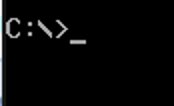
Once upon a time, one of the readers, jerome, asked me to write a comparison of HP LX palmtops. While I consider it a little pointless (the 200 LX would take all the gold), a review of all then-popular palmtops with DOS onboard wouldn't be a bad idea, I guess. An exact comparison would make little sense though - to be fair, Atari Portfolio would be crushed by machines such as the abovementioned HP 200 LX - so I'll try to tell the story in a different way and show the pros and cons of each computer.
First of all, take a look at the List of DOS-based palmtop computers. I think it's the most comprehensive and informative place on the Internet, and the list is really overwhelming. Actually, most of the brands are clones and the choice today (e.g. when hunting on eBay) is limited to only a few major names.
Atari Portfolio
The winner of our survey, the Portfolio is a machine that "has that something". I haven't heard of any other DOS-based palmtop with such a cult following. Not 100% DOS-compatible, Pofo earned lots of programs written for it and even kind of a "scene" back in the days. The remainings of that hype can still be found in the Downloads section of The Portfolio Website.
That said, Atari Portfolio is rather a "plastic-and-silicon teddy bear" than a tool that could be used on a daily basis. Its main flaws include:
- compatibility issues (operating system, screen) resulting in most of the DOS software failing to run
- fallibility - you can't tell if your data will be there tomorrow; if you want to have a peaceful sleep, better invest in a RAM card
- crappy built-in software; you don't have to use it, but if you want to have a PDA, there's a risk you'll be driven crazy by its peculiarities (my favourite is the first day of a week fixed to Sunday)
- too little memory (it's possible to expand RAM to 640 KB, but out of the box you get only 128 KB for internal disk and system RAM)
But keep in mind, that twenty years ago it was widely used by professionals, sometimes under heavy-duty conditions (in manufacturing, forestry and so on). So maybe I'm just biased?
The Portfolio was commonly used as a "typewriter". For long I was skeptical about its keyboard, but eventually I discovered that with key click turned on typing gets quite comfortable (but the battery lifespan decreases). There's even an incredible text by Rowby Goren about how to touch-type on the Portfolio and use it while having a walk. The screen is small (in terms of rows and columns), but characters are large and easy to read.
HP 95 LX
Produced two years after Atari Portfolio, it's obviously technically superior. With larger RAM, built-in serial interface, twice as big screen and smaller size, it seems to be no competitor for the Portfolio. But talking about the usability, its superiority is not that obvious. First, it has the worst keyboard among all the palmtops reviewed here. Not only does it seem to be taken from one of HP's calculators, but also the layout requires much time to at least get familiar with, not to mention fast typing. Built-in software is not much better that that of Portfolio - excluding the spreadsheet (real Lotus 1-2-3 v. 2.2) and excellent calculator. Besides, I don't know if it's common in this model, but my 95 LX works very bad with rechargeable batteries; it seems to me that its voltage meter is set too high and it can't deal with rechargeables' steep discharge curve. The "battery low" message appears suddenly and it's impossible to work anymore. Moreover, when left for a few days, the computer can lose all the data as the batteries get drained. I read somewhere, that I'm not the only one, but maybe this issue appears only in some machines.
HP 95 LX is equipped with MS-DOS 3.22, and it's MS-DOS, not a custom DOS like Portfolio's DIP-OS. This allows for launching more DOS programs, I even managed to play ZZT 🙂 But the screen is still incompatible with CGA, so forget graphic games. There is some software written specifically for the 95 LX, that can be downloaded from RetroIsle.
HP 200 LX
HP 95 LX's younger brother is considered by many as the best DOS-based palmtop. In the 95 LX's skin (the same size and weight) is a regular PC XT with MS-DOS 5.0 and CGA-compatible display. You can run most of the DOS software on it, yet there are lots of 200 LX-specific programs. The keyboard however remains almost unchanged, making it a great PDA (superb built-in PIM software!), but a mean word processor.
The drawback of an 80x25 screen in a small case is the size of characters. Imagine letters half the size of those on 95 LX's screen - it's a chore when you use text-mode applications.
Tidalwave PS-1000 and clones
It's hard to find the original Tidalwave PS-1000, but the company was really prolific when it comes to manufacturing under other brand names. Much more common are Zeos Pocket PC (in the USA), Highscreen Handy Organizer and Peacock Palmtop PC (in Germany). They are identical, the only difference being the operating system and keyboard layout (German vs. American).
Larger than the Portfolio, these machines in fact are rather (much) smaller laptops than pocket-sized PDAs like the HP LX series. The keyboard is really comfortable, if you get used to accidental turning off the computer instead of hitting backspace (completely harmless). The screen is CGA compatible, with 80 columns per 25 rows of text, but it's larger than HP 200 LX's, so the letters are easier to read (but they are still much smaller than on HP 95 LX's or Portfolio's display).
Built in is MS-DOS 5.0 with MS Works and Race Pen (PIM software). The applications are quite uncomfortable and can't beat HP 200 LX's suite, but that's my opinion, of course. "Tidalwave-oids" are the only machines equipped with a programming language - MS QBASIC interpreter.
Tidalwave has both serial and parallel ports, but (as many other palmtops) miniature, custom versions rather than standard, which would be ideal. As for now, I couldn't find the pinout of these ports, so I don't know about running external software on this machine. I guess that - as it is with HP 200 LX - most of the programs should run flawlessly.
Others
There are a few more models, but having never seen them I can't write anything more than: "boy, they are rare". Judging by the parameters, I would recommend one of the "Tidalwave-oids" rather than Poqet PC or Sharp PC-3000/3100. The latter two have MS-DOS 3.30 installed and CGA-compatible display, so most of DOS apps should run.
Atari Portfolio as an e-book reader
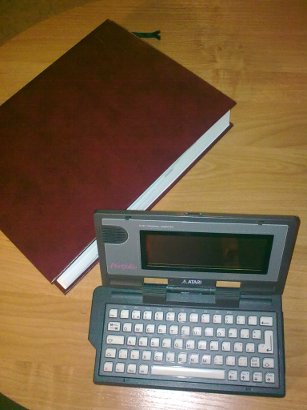
You may think that the Portfolio is no good for reading books, but well, people read on smartphones (3,5" backlit screen with tiny letters on it) or laptops (3 kg or so), so why not give Pofo a try? After all, its screen is clear and readable (though small) and I heard of users having read quite a lot of literature on it back in the days.
The famous BJ Gleason once wrote a text viewer that became the best solution for reading books on the Portfolio. It is not only a viewer, but also a utility that "incorporates" the content into the program, making a single .com file that can be compressed, shrinking it to about half the size of the raw text (!). A few fiction and non-fiction books have been made, some of which you may find here.
If you want to make your own, here's the easy way to do it, provided you have a Linux machine. I'm sure that these tools (sed, fold, split) are also available for Windows, but surely not out-of-the-box 😉 You'll also need either DosBox or a real DOS machine.
First, choose the book you want to have on your Portfolio. It can be pdf, epub, mobi or any of the popular formats. It shouldn't be too long (though theoretically it may be even "Ulisses", it would simply make more parts), and you'd better choose something without fancy graphics and baroquesque formatting - or you'll get quite a mess after conversion.
Enter http://www.online-convert.com/ and convert the file to .txt (raw text) format. Now the processing part.
1. Remove all custom Unicode characters (or national characters if the book is not in a Western language):
iconv -f utf-8 -t 437//TRANSLIT file.txt > file_1
2. Remove abundant newlines, which have probably appeared after conversion:
sed -r 'N; s/\n+//g' file_1 > file_2
3. Wrap the text at 39 columns:
fold -sw 39 file_2 > file_3
4. Since the size of the file probably exceeds 60 kilobytes, you need to split it to smaller parts:
split -n 3 -d file_3 chunk_
(if you want to split it into three parts; you may also use "-b size" to get the chunks of exactly that size in bytes)
5. You get a couple (in our example three) of files, e.g. chunk_00, chunk_01 and chunk_02. Now the editor's work, especially gluing back the paragraphs broken in the last step. It's also good to check the text against any suspicious characters that might have appeared or weren't correctly transliterated. (Note for Polish users: the letter "ó" will be replaced with its 437 code page equivalent by iconv, and that might look messy in some editors. Don't worry, it will be correctly displayed on the Pofo.)
6. Change the newline characters to the DOS format:
sed -r 's/$/\r/' chunk_00 > ch1
sed -r 's/$/\r/' chunk_01 > ch2
sed -r 's/$/\r/' chunk_02 > ch3
7. Move the resulting files (ch1, ch2 and ch3 in our case), as well as the makeread and compack utilities to a directory accessible by DosBox and run the emulator.
8. At the beginning of each chapter/part (just before its title) add an ASCII 254 character (Alt-254). You can do it using most of the text editors available for DOS, for instance that coming with Volkov Commander. These markers will allow you for easy navigation through the book.
9. Make a .com version of each file:
makeread ch1 ch1.com
makeread ch2 ch2.com
makeread ch3 ch3.com
10. Compress them:
compack ch1.com part1.com
compack ch2.com part2.com
compack ch3.com part3.com
That's all, the book is waiting for your hungry eyes 🙂
The phenomenon of Atari Portfolio
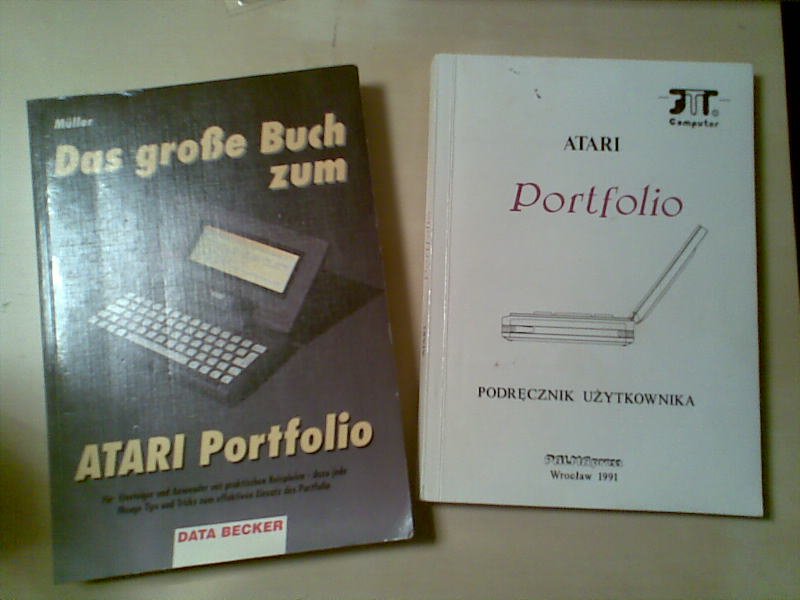
When asked about Atari Portfolio, a "retrocomputing regular Joe" would say about "the world's first palmtop" (not true, obviously) or John Connor breaking into an ATM. It seems, however, that Portfolio's popularity goes beyond these clichés; I can't rely on the survey I recently did (13 votes, shame on you!), but the statistics of this blog don't leave any doubt - most of the visitors coming here are looking for something related to the Portfolio.
Thanks to its moderate price Atari Portfolio gained much more popularity than other palmtops of those times, especially in Europe. In fact, in countries like Poland or Czech Republic it was the only palmtop that could be easily afforded by "the masses" - and that explains the explosion of homebrew software and hardware made in this part of the world. Especially Czech achievements - from the fast graphic routine to sophisticated built-in CF reader - have made a big impact on the Portfolio and the community around it.
I don't know, though, why Portfolio was so popular in Germany. Made it was because of its internal simplicity, so much corresponding to German "tinkering spirit". The not-so-long-ago-abandoned (or is it still alive?) PofoWiki features many hacks and tweaks - hardware- as well as software-wise, like extremely useful fancy batch scripts (!).
Atari Portfolio had many flaws - bugged ROM, badly designed screen hinges, lack of essential accessories out of the box etc. - but it was and is extremely popular, comparing to its competitors of that time. I guess that it's like with ZX Spectrum: maybe technically it couldn't compete with other 8-bit home machines, sure it had its flaws, but it is now among the most popular vintage computers and it has probably the most thriving community of devoted fans, with the amount of newly created software and hardware far exceeding other 8-bits.
What do you think? This time I really expect feedback if you want to have more and more Atari-related stuff on this blog. "Or else..." 😉
Games: A for Adventure

One of the fields where vintage palmtops can easily compete with modern gadgets, is adventure gaming. I mean those games where you type "examine box" and the computer tells you that there is a small piece of paper inside. Or something else. A lot of games were written for portable computers in the heyday of adventure gaming (80's and the beginning of 90's).
If you don't know, what these "adventures" are about, read the excellent introduction by Joe W Aultman or an exhausting beginner's guide at Brass Lantern.
Psion Organiser
Yes, there are adventures for the Organiser. You may download a port of Colossal Cave Adventure and an original game "City of Alzan" from The Psion Organiser II site. They should run on an CM! (haven't tested though)
[EDIT 2025-10-18]
By far the best adventure game for the Organiser is Strutsul Island by Martin Reid. You can download it (together with an excellent instructions manual) from the Psion Organiser II Forum.
Psion Series (SIBO)
With these machines you can access all Infocom titles (.IDF format) thanks to the ITF Interpreter by Bryan Scattergood. You can download it as well as Zork I from BioEddie's.
Psion Series (EPOC)
For Psion 5 (and higher) there is FrotzS5 Z-Code interpreter. This lets you play hundreds of games stored on Interactive Fiction Archive website and elsewhere on the Internet. You may also want to take a look at this page, where you can find a brief installation info together with an entire Zork trilogy for download. (Here's an archived instruction manual for FrotzS5.)
Amstrad NC
There are a few amusing adventure games available from Tim's Amstrad NC Users' Site, like "Crystal of Nebumeth". NC's full-sized keyboard and large screen make it really comfortable to play adventures even for a long time. Amstrad has a BBC BASIC interpreter built in, so new games may be easily written (the source codes of existing games may help you get started).
Atari Portfolio
You can download a few games from atari-portfolio.co.uk. I don't think that any DOS Z-code interpreter would run on a Portfolio, but I didn't even try. Maybe there is a lightweight version, capable of running on a very basic XT?
EDIT: There is an interpreter with a few games (including Zork Trilogy). You can download it from PofoWiki's download section (infocom.zip).
HP LX
There are some titles on the S.U.P.E.R. site. You need to be patient, though, and click through those hundreds of programs listed (no categories). DZip (16-bit DOS version) should run on every LX (most likely on 200LX).
Palm
There are a few Z-code interpreters for Palms, like Pilot Frotz or Pilot Zip, but I've used only one of them - Frobnitz. It supports all Z-code file formats (except V6) and is quite powerful, but larger games are slow like hell on my IIIe.
Useful links:
- Interactive Fiction Archive with lots of games, interpreters, utilities, articles and so on
- Interactive Fiction Competition where you may find excellent new titles every year
- Brass Lantern - for interactive fiction fans
How to send comms software to Portfolio over the serial port
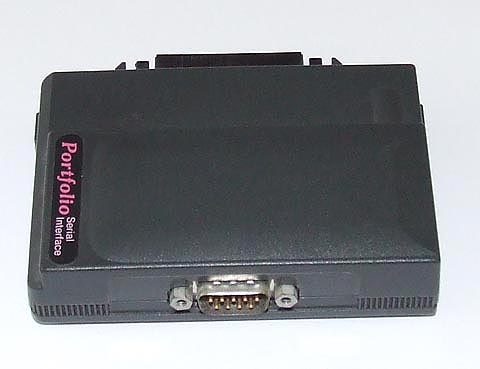
Hey, I just found something. It seems that someone solved the "chicken or egg" problem with Portfolio's serial interface: the computer has no serial communications software built in, so it's impossible to send any from the PC and, unless you have a parallel interface, you're virtually unable to use the serial port to transfer files. Digging through the files on atari-portfolio.co.uk I accidentally spotted this. It's a tiny program that sends Xterm2 to the Portfolio over the serial port.
I haven't tested it (for I don't have a serial interface), but I bet it would work, with a simple yet brilliant idea behind it.
Finally. A new game for Portfolio

This year's Grzybsoniada party witnessed the glorious comeback of Atari Portfolio. "Diabelska Pomyłka" - a text game with Innuendo's script and graphics and my code (Portfolio Basic yeah!) took the first place (of 1 competitors for this platform) in Wild Compo 😀
The game is in Polish, but hopefully some day an English version will appear. However, you may want to write your own text game and that's why I chose Portfolio Basic (I wouldn't advise you to use it otherwise) - in my humble opinion the engine is simple enough for anyone with - nomen omen - basic programming skills to use it for creating their own game or even to modify it. It comes with 48x8 text mode (with user-definable characters) and PGC support (actually built-in PBasic's feature). The only drawback is the annoying speed, making reading longer chapters boring.
I'm about to re-write the 48x8 (or even 48x9) engine in assembler, so that it would allow coders to write cool adventure games, ebook readers etc. It should be ready for Christmas. Don't know the year, though...
Download the game from the Download section.
RAM expansion for Atari Portfolio

UPDATE [2020/04/12]:
By popular demand, I decided to take more detailed photos of the expansion board and post them here. The author is (apparently) unreachable, and I don't have any schematics or technical knowledge of the circuit, so please, don't ask me about it. I won't be able to help.
The original RAM (U5-U8) has been removed. The board is one-sided; the numbers on the two chips are as follows:
CY62148ELL-
45ZSXI
1113 618819
F04
HC08
13KG4
C8TJ
It's been a long time since I wrote here. SillyVenture 2k11 is over and I was there, but had no time to write even a short report. Today I promised myself to write a post, that has been waiting in a queue for long.
RAM expansion. The must-have mod if you want to use something else than the built-in software on your Portfolio.
Already in the 1989 128k was too little. With 4 kilobytes taken by display RAM, at least 8 KB used as ramdisk and some memory used by system (depending on FILES and BUFFERS settings in CONFIG.SYS), less than 100k was available for the program. With 40-kb ramdisk (absolute minimum when you wanted to upload some software) you were left with no more than 60 kilobytes. RAM expansions appeared soon after Portfolio, the first ones being large, uncomfortable interfaces mounted to the expansion bus. Early mods built in the Portfolio were two times the price of the computer. As years were passing by, more and more sophisticated solutions were emerging for affordable prices - both commercial and fan-made.
In the 2000s, with the twilight of Atari Portfolio, RAM expansions have become extremely hard - if not impossible - to acquire. This makes the computer virtually useless for any applications but using the built-in software, especially for coding. It was clear for Maestr0 - a talented constructor who decided to create a new 512 KB built-in RAM expansion for Atari Portfolio.
Apart from expanding my Pofo's RAM, Maestr0 replaced the capacitors, making my computer run 10 minutes without batteries!
Maestr0's construction includes a small PCB mounted on the Portfolio's mainboard. It's intended to be as cheap as possible and easy to assemble. When the author decides to release it, I'll inform you about pricing, shipping conditions and how to purchase.
